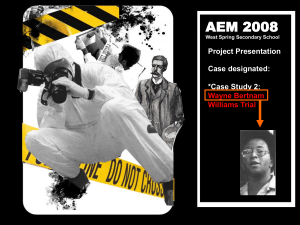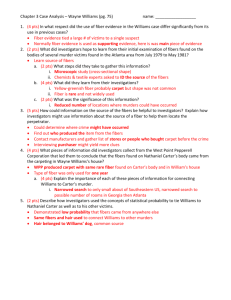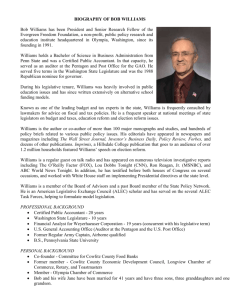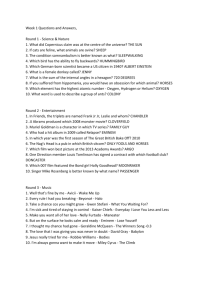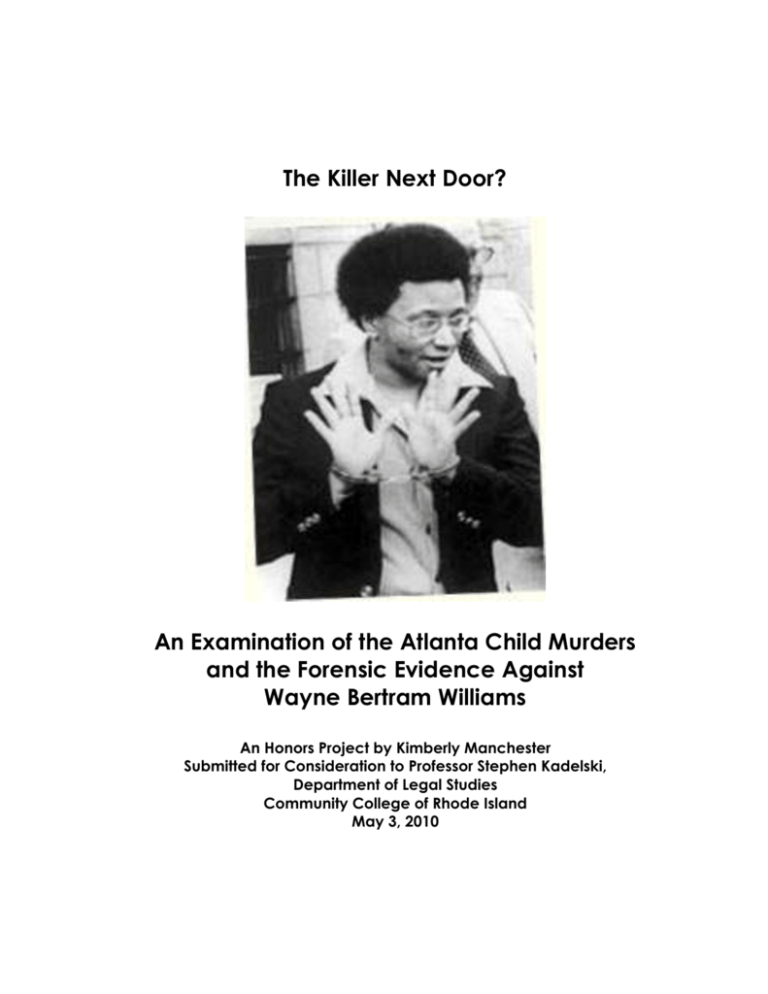
The Killer Next Door?
An Examination of the Atlanta Child Murders
and the Forensic Evidence Against
Wayne Bertram Williams
An Honors Project by Kimberly Manchester
Submitted for Consideration to Professor Stephen Kadelski,
Department of Legal Studies
Community College of Rhode Island
May 3, 2010
Preface
It was the summer of 1978 and the Greater Atlanta area was under siege by
violent crime. Murder was commonplace; and tourists and business travelers alike
steered clear of “the city to busy to hate” (James Baldwin). The racial divide
between Black and White was deeply rooted, and no amount of civil rights
legislation was going to change that, when the political landscape took a sudden
turn, and the skin color of Atlanta’s leaders started reflecting that of its citizens. The
hope was that now that black leaders were in charge, perhaps the violence
towards black people and by black people would fade, and life could return to
normal. That hope was dashed by the summer of 1979, when the bodies of
murdered black children started showing up in the woods, rivers, and roadside
ditches of the small towns that make up the Atlanta suburbs; discarded like trash by
someone with an affinity for adolescent boys. The violence had not stemmed.
Worse, in the minds of those affected, was that this was obviously a black-on-black
crime.
Think for a moment about the makings of a suburban neighborhood. People
all know each other. Although they may not know every name; the faces are all
familiar, and the families are, for the most part, all similar. Suburban Atlanta in the
late 1970’s and early 1980’s was no different from the rest of suburban America,
except that its neighborhoods were predominantly to exclusively black. From the
local store owners to the police officers walking the beat, a white face was a rare
sight; and, like all things out of place, something to distrust. A child riding his bike
would not stop to offer directions to a white stranger. A boy walking home after a
Wayne Williams and the Atlanta Child Murders
long day at play would not accept a ride home from someone so different from
himself. The killer, Atlanta had decided, had to be someone who looked like them.
It had to be someone who walked among them; and someone who could blend
with the fabric of black society.
To most people, the name Wayne Bertram Williams does not mean a thing.
However, in the history of law enforcement and criminal forensics, Williams’ name is
as unique and as recognizable as a fingerprint. Wayne Williams was convicted of
only two of the more than two dozen murders that occurred in the Atlanta area
during the 22-months covering July 1979 – May 1981; however, he was implicated in
ten more of them.
It is both a controversial and memorable case; and Williams is a study in
forensics unto himself. His was the first major case to be tracked using psychological
profiling; and to this day the only person ever to be convicted on the basis of hair
and fiber evidence that left no room for reasonable doubt that he was present at
the scenes of the crimes. These facets of the case are what make it so memorable.
The fact that Williams was never tried for the ten additional murders of which he
stood accused are what make the case so controversial. The only evidence against
Williams for these additional crimes was the hair and fiber evidence that connected
him to the crime scenes and the bodies of the victims. Could it have been enough
to convict him, as it was in the other cases, if he were to be tried?
To follow is a report in two parts: the first is an overview of the investigation of
the Atlanta Child Murders case; and the path of evidence linking Williams to the
Manchester, 1
Wayne Williams and the Atlanta Child Murders
murders. The second part is an in-depth look at the unusual evidence against
Williams; and the possibility – in this particular case – that justice is still waiting to be
served, even as Williams serves his time in jail.
Part I: The Investigation
More than a dozen child murders had occurred between the summer of 1979
and winter of 1981; and all had appeared to be committed by the same person, as
the modus operandi was the same: A black male child between the ages of 10 – 15
would be abducted from his neighborhood; asphyxiated; stripped of most clothing;
and dumped somewhere along the local landscape. This, unfortunately, was all the
police had to go on...by the time the bodies were found, they were usually in
moderate to advanced stages of decomposition. Fingerprints could not be lifted; a
weapon could not be found; and most other hard evidence was destroyed, if it had
even existed in the first place (Baldwin).
There was, however, one piece of evidence that kept cropping up on many
of the bodies: yellowish-green nylon fibers, sometimes mixed with violet acetate
fibers; other times in conjunction with what police would later discover to be dog
hair – but always the yellowish green nylon fibers…
From the case of the Boston Strangler to that of Jon Benet Ramsey, police
investigators have always held back details of certain pieces of evidence found at
crime scenes. One reason is to dissuade false confessions – if the confessor does not
know the details; they could not possibly be the killer. A second reason for holding
Manchester, 2
Wayne Williams and the Atlanta Child Murders
back key evidence was illustrated in the Wayne Williams case.
In February 1981 The Atlanta Journal-Constitution, the local newspaper which
had been steadily reporting on the rash of murders of local black children, published
a story about the mysterious yellowish-green nylon fibers that had been cropping up
on the bodies of the slain boys, in the hope that the publicity would help the police
find a lead on the source of the unusual fibers (Baldwin). In all, 25 fibers had been
found on over a dozen corpses, indicating the possibility that the crimes had all
been committed by the same person or persons. From that point on, the bodies of
the murdered youths were no longer found dumped in ditches, ragged clothing
clinging to their remains. From that point on, the bodies were found stripped of all
clothing and dumped in local rivers and streams, washed clean of almost all trace
evidence. Almost all trace evidence.
By this point, FBI investigators from the Atlanta Chapter had been called in to
work on the case of these serial murders, as it was receiving national attention. At
the time, an agent from the FBI’s Behavioral Science Unit, John Douglas, was
working to prove the validity of a new form of criminal investigation: Psychological
Profiling. Douglas believed that the nature, setting, and time of day in which the
crimes were committed; the choice of victims and what characteristics they had in
common; the manner in which the bodies were disposed of, and the types of sites
at which they were disposed all came together to indicate the type of person who
was committing the crimes (TruTV.com).
From there, it was only a matter of
concentrating on the narrow pool of potential suspects that fit the profile, and could
reasonably be linked to the crimes.
"I use a formula," said Agent Douglas for
TruTV.com, "How plus Why equals Who. If we can answer the hows and whys in a
Manchester, 3
Wayne Williams and the Atlanta Child Murders
crime, we generally can come up with the solution."
Common sense led
investigators to believe that the killer was black. What new leads would this new
“profiling” method bring?
The killer in this investigation was determined to be an “organized” killer – one
who planned ahead; and although his victims may have been chosen by sheer
opportunity, the methods used to obtain them were not. The killer had a plan of
action used to lure victims, a vehicle in which to transport them (and their remains, if
necessary), and a weapon or weapons of choice used to commit the crimes (in this
case, strangulation and/or blunt force trauma). It was also discovered – since the
killer had been made aware of the trace evidence against him – that he preferred
the famous Chattahoochee River as his primary dumping site. This preference was
to be the killer’s undoing.
The killings continued with the usual frequency of one or two – sometimes
three – a month until May 1981, when the FBI used the profile they had created to
set a trap for the killer. On May 21, 1981, Atlanta police, along with the FBI, set up a
stakeout of the Chattahoochee River.
places along the banks.
They hid under bridges and in strategic
Around 2 AM, a loud splash from the James Jackson
Parkway bridge was heard, followed by the sound of a car slowly pulling away, as if
its driver did not wish to be heard (Saferstein).
The vehicle, it turned out, was a white Chevrolet station-wagon driven by a
man named Wayne Williams, a self-professed music producer who had nary a
successful client to his name. The Atlanta police followed Williams for about half-amile before he was stopped by the FBI and questioned about his activities on the
bridge (TruTV.com).
Manchester, 4
Wayne Williams and the Atlanta Child Murders
Although it was well into the early hours of the AM, Williams claimed he was
looking for the address of a “prospective client”, as he had an appointment with her
at 7 AM that morning (TruTV.com). The FBI thought this story sounded unbelievable,
and rightfully so when the phone number of the supposed client was not in service
and the address Williams gave did not exist (Baldwin). When asked, Williams gave
FBI agents permission to search his car; but nothing unusual was found – or so they
thought.
Unbeknownst to them, the agents had stumbled upon some very
important evidence.
The next day, the Chattahoochee was dredged in the region of the Jackson
Memorial Bridge, but no body was found. Williams was questioned further, as to his
presence on the bridge, and he claimed that he had been “dumping garbage”
(Saferstein). Williams was also questioned as to his whereabouts the previous day,
and it was discovered that his claims of his whereabouts were completely false.
Williams was not, as he claimed, “playing basketball at the Ben Hill Recreation
Center” and picking up recording equipment at the San Souci Lounge (TruTV.com).
This, of course, begged the question: Where was Williams; and what had he been
doing in the hours prior? Investigators did not have long to wait before finding
another piece of this puzzle.
On May 24th – three days after Wayne Williams was “dumping garbage” off
of the James Jackson Memorial Bridge – the body of 28-year-old Nathanial Cater
was found floating in the Chattahoochee River, only about 1 mile from where the
Jackson Memorial Bridge crossed. The corpse had been stripped of all clothing; but
a single yellowish-green nylon fiber clung to the hair of the victim. Microscopic
comparisons showed that it was the same type of fiber as reportedly found at other
Manchester, 5
Wayne Williams and the Atlanta Child Murders
murder sites in the area. Although the age of the victim was an outlier; the method
of killing (asphyxiation); the dump site (the Chattahoochee River); and the trace
evidence all fit the profile of the crime wave’s killer.
Combined with Wayne Williams’ lack of an alibi – and his lies to the police
and FBI investigators – a search warrant for Williams’ home was secured. It was
executed on June 3, 1981, and it was then that police found what they thought was
the source of the yellowish-green nylon fibers found on Cater’s body, as well as
violet colored acetate fibers and dog hairs found on the bodies of other victims: a
carpet inside the Williams home was made of yellowish green nylon; his family dog’s
hair matched the dog hairs found at the scene; and Williams’ bedspread was a
match for the violet acetate fibers.
Further investigation showed that fibers from the rugs of a car Williams drove
matched fibers found on another murder victim. Investigators, it would seem, had
found Nathanial Cater’s killer, and in the process discovered the killer of a second
local man, Jimmy Ray Payne, whose murder during the previous month was a mirrorimage of the murder of Nathanial Cater: death by asphyxiation; body dumped –
naked – into the Chattahoochee River; similar fibers as found on Cater found
sticking to the corpse.
During the following weeks, investigators continued to question Wayne
Williams, who failed three separate polygraph tests in which questions regarding his
connection to the murders were asked (FBI.com). Two months after that fateful
night on the James Jackson Memorial Bridge, Wayne Williams was arrested and
indicted on two charges of murder for the deaths of Nathanial Cater and Jimmy
Manchester, 6
Wayne Williams and the Atlanta Child Murders
Ray Payne. Investigators had no doubt in their minds who had been killing the black
youth of suburban Atlanta. The problem would be convincing a jury.
Fibers are not like fingerprints in the respect that they cannot be
individualized. However, like DNA, if the characteristics of the fiber are rare enough
their origin could pass the test of reasonable doubt. Unfortunately, investigators had
a long road ahead of them to prove the rarity of the yellowish-green fibers that
would make or break their case against Wayne Williams.
Part II: The Fiber Evidence
Originally, investigators in the Wayne Williams’ case hoped that the unusual
carpet fibers found on the bodies of the victims would lead to avenues of
investigation – if they could find out from where the fibers came, perhaps it would
result in a lead in the case. They had no idea that the fibers would become the
whole case! The following facts are noteworthy because of the large number of
forensic investigating techniques that were employed in the attempts to identify the
carpet fibers; suggesting that they were the “smoking gun” the prosecution needed
to convict Williams – which sets the fiber evidence from the Williams case apart from
other cases of its time, and cases since.
As previously mentioned, hairs and fibers cannot be individualized like
fingerprints or tool-marks.
They can simply be classified according to possible
sources – i.e. “negro male” or “canine” for hair and “nylon” or “cotton” for fibers. In
most cases, a forensic scientist can prove that rug fibers are similar to a rug in a
Manchester, 7
Wayne Williams and the Atlanta Child Murders
suspect’s home; but s/he cannot prove definitively that the fibers came from the rug
in the suspect’s home without overwhelming supporting evidence (i.e. skin cells from
the suspect clinging to the carpet fiber). A single fiber is generally not enough to
lead to an evidence trail. Therefore, they are generally not used to validate a case
against a suspect; but used to support other evidence that links a suspect to a
crime.
The Williams case, however, is not like most cases. The fiber evidence in the
Wayne Williams case veered from the norm in that it was the main evidentiary
finding against Mr. Williams; and other forms of evidence were used to support the
credibility of the fiber evidence – a complete turn-around from the traditional use of
fiber evidence. Furthermore, the fiber evidence in this case differed from others by
the fact that the microscopy of the fibers was so “unique” that the manufacturer of
the carpet from which it came was “difficult to determine”, even by industry
professionals (Saferstein).
Attempts to identify the fibers found on the murder victims took authorities on
a detailed chase. The photomicrographs (pictures taken of the fibers while under a
microscope) were distributed to Chemists working in the fiber industry but none
could initially identify the manufacturer.
They could only agree that the cross-
sectional cut marks on the fiber were unlike any they had ever seen.
After continued investigations – most of it unfruitful – the source of the fibers,
found during a warranted search, turned out to be a yellowish-green carpet in
Wayne Williams home. It was obvious to investigators that the fibers were a match;
but what if they matched other carpets in the area? Could further investigation
show this to be unlikely? From here, the search for the manufacturer of the carpet
Manchester, 8
Wayne Williams and the Atlanta Child Murders
took on an even bigger sense of urgency as the need to prove the exclusivity of the
fibers drove the investigation against Williams.
In their search for information on the carpet fibers, the police were led to the
Wellman Corporation, a local textile manufacturer; but unfortunately, Wellman had
only manufactured the fibers for the creation of the carpet – not the finished
product, and could therefore not testify to the exclusivity of the unique cross-section
cut of the fibers that had puzzled field professionals. Although investigators were not
pushed back to square one, they had not advanced beyond square 2; and it
appeared that they may have hit a dead-end. Investigators continued the search
for a manufacturing source.
Authorities compiled a list of information on the carpet fibers, furnished by
Wellman Corporation, which included the technical information about the fiber; on
when it had been manufactured; on what companies had purchased it; and
information on when and how much of the fiber had been obtained and to what
purpose.
It was then that they learned that the unique fibers had a limited
production run of only seven years, so they narrowed their search to encompass
only purchases made during that time frame.
Numerous industry contacts were made before discovering that the West
Point Pepperell Corporation (Dalton, GA; only an hour outside of Atlanta) had
manufactured a carpet in the exact color and with the same fibers found in Wayne
Williams’ “English Olive” (a.k.a. yellowish-green) colored carpet. This carpet, which
had the unique cross-sectional cut markings that police were seeking to match, was
eventually discovered to be of an even further limited issue – in fact, it was only
manufactured for one year, resulting in presumed rarity of the fiber, an unusual trait
Manchester, 9
Wayne Williams and the Atlanta Child Murders
in and of itself. This combination of unique cross-cut and limited issue drastically
narrowed the statistical probability that this particular carpet was widespread
throughout homes in the Greater Atlanta area.
A statistical study (something never before executed for textile evidence in a
criminal trial) later showed that the chances of anyone who was living in the Atlanta
area AND having the same carpet as found in the Williams’ home to be less than 1
in 7500 (FBI.com). These factors worked in favor of the prosecution, as the defense
could not claim that the carpet from which the fibers came was a common one,
and could be found in households across the state or even across the country.
These findings were important to the prosecution in the Wayne Williams case
and significant to the case against Williams because they greatly reduced the
reasonable doubt that the fibers found on the murder victims came from anywhere
but the carpet in the Williams’ home. Nevertheless, there could still be reasonable
doubt that these carpet fibers were not rare enough to be from only one local
source. Prosecutors needed investigators to show that these fibers were indeed
from Wayne Williams’ place of residence.
Luckily, somebody in the Williams’
household was not a stickler for clean.
Investigators found what they were searching for in Wayne Williams’
bedroom: Fibers from the bedspread of Williams’ bed and hairs from his family dog
matched other fibers and hairs that had been found on the murder victims; thus
further reducing the probability that the carpet fibers came from somewhere else
and supporting the theory that they came from Williams’ home.
Furthermore,
additional fibers from the crime scenes (mingled with the carpet fibers) were found
to come from Wayne Williams’ station wagon, as well as other vehicles to which he
Manchester, 10
Wayne Williams and the Atlanta Child Murders
had access (FBI.com). All in all, 25 hair and carpet fibers were found at various
murder scenes, an amount considered by forensics experts to be “overwhelming”
(Saferstein). If Williams was not the killer, somebody in his household was. How can
this be definitively stated?
In a general sense, knowing the source of a fiber can help investigators
narrow the search for a suspect. If a carpet fiber from a known source is found on a
victim or at the scene of a crime – and the source is not continuous with the crime
scene – there is a possibility of finding the suspect at the source of the disjunctive
fibers.
With cooperation from the West Point Pepperell Corporation, investigators
discovered the following information about the carpet fibers found on the bodies of
twelve murder victims, including Nathanial Cater and Jimmy Ray Payne:
1. That West Point Pepperell had manufactured a line of carpeting called
Luxaire, which was manufactured with the same fibers as found in Wayne
Williams’ rug
2. West Point Pepperell was the only known carpet company (existing or
defunct) to use this fiber in its product, in the exact chemical make-up of
the color in both the fibers found at the murder scene and the fibers in
Wayne Williams’ carpet
a. The possibility of two separate manufacturers using the exact same
chemical processes and ingredients to create the exact same
color is extremely rare at best, as both are protected by patent
and copyright laws, respectively; and
b. Other, visually similar green carpets were compared to the fibers
found at the crime scenes; and none were found to be
microscopically similar
3. The unique carpet fiber pattern found in both the fibers taken from
Nathaniel Cater’s body and Wayne Williams’ rug was used exclusively in
the manufacturing of Luxaire English Olive colored rugs for a period of one
year – after which a dissimilar fiber was used to produce the Luxaire
carpet line
Manchester, 11
Wayne Williams and the Atlanta Child Murders
4. The approximate amount of this unique carpet in the English Olive color
sold in the Southeast United States was quite low – less than 16, 500 square
yards. Simply put:
a. An estimate of existing carpeted floor-space in the U.S. during this
time was 6.7 billion square yards, giving Luxaire English Olive only
.00000245% (2.45 x 10-6% ) of the U.S. carpeting market
b. Further probability estimations showed that approximately 82 rooms
in the entire state of Georgia (out of over half-a-million occupied
homes) were carpeted in Luxaire English Olive
Each of these facts was important in connecting Wayne Williams to Nathaniel
Cater’s body because all were necessary to reduce the probability of the carpet
fibers coming from an identical rug in the Atlanta area. If any one of these facts
had been absent, the distribution of the carpet would have been much greater,
thereby increasing the statistical probability that the fibers did not come from
Wayne Williams’ carpet; but from a similar carpet owned by someone else.
These facts, presented as they are, sound like a slam-dunk conviction for the
prosecution. However, statistical probability involves a great deal of higher math;
and can be difficult if not impossible to explain to someone untrained in the subject
– i.e., a typical jury. Further muddying the waters is the fact that when most people
hear the word “statistics” they think of Social Statistics, not Scientific (Forensic)
Statistics; which are two widely differing concepts.
should happen, given a situation with set variables.
Social Statistics predict what
Forensic Statistics take into
account the often ignored variables that can change the forecast of what “should”
occur – very much like “Chaos Theory”.
For example, if a U.S. coin is tossed into the air 100 times, Social Statistics state
that it will land on “heads” 50% of the time, and tails the other 50% of the time, as
these are the only two available options. Forensic Statistics takes into account the
Manchester, 12
Wayne Williams and the Atlanta Child Murders
fact that the “heads” side of the coin is embossed, whereas “tails” side of the coin is
both embossed and engraved. This slightly changes the aerodynamics of the coin,
and will favor a “tails” result approximately 53% of the time over repeated coin
tosses.
Forensic Statistics, though useful, cannot always be employed to the level of
legal accuracy required in a courtroom.
For this reason, the less precise Social
Statistics are what investigators used to calculate the statistical probability of other
Atlanta residents owning the same Luxaire English Olive carpeting, from which fibers
were discovered on several of the murder victims, including Nathaniel Cater.
The facts taken into account when creating the study led scientists to the
probability of randomly selecting a house within a reasonable radius of the crime
scene (metropolitan Atlanta).
That probability was 1 in 7,792, not taking into
account that much of the Luxaire English Olive carpeting sold between 1970 – 1972
could have been destroyed by 1981 (when Nathaniel Cater was murdered), as the
normal lifespan of the carpet was estimated to be 4 – 5 years [these variables fit into
the mold of Forensic Statistics] (Saferstein).
Not taken into consideration was the probability of the Luxaire English Olive
carpet fibers occurring in conjunction with other fibers (also linked to Williams) found
on the bodies. If a Forensic Statistical study were done, then statistically speaking
the odds would be infinitesimally small – as close to zero as science can predict –
and yet all fibers found on the murder victims bodies were found together in
Williams’ station wagon, as well as other vehicles to which he had access.
Even without the added Forensic parameters, these overwhelming statistics
left no room for “reasonable doubt” that the carpet fibers found on Nathaniel Cater
Manchester, 13
Wayne Williams and the Atlanta Child Murders
– and ten other murder victims of the 22-month killing spree that Williams’ was
accused of perpetrating – came from Williams’ carpet; thus tying Williams to the two
murders of which he was formally accused; and at least ten others of which he was
suspected.
In January of 1982, a jury of nine women and three men – eight white and
four black – returned a verdict of “guilty” against Wayne Bertram Williams on two
counts of murder, for the killings of Nathanial Cater and Jimmy Ray Payne. On
February 26, 1982, Williams was sentenced to two life sentences (FBI.com). With his
conviction, the FBI investigation into the Atlanta Child Murders was closed; the
concept of forensic profiling was accepted as a valuable form of criminal
investigation; and the name of Wayne Bertram Williams quickly faded from the
minds of most Americans, becoming a mere footnote in American criminal history.
Manchester, 14
Wayne Williams and the Atlanta Child Murders
Afterward
Wayne Bertram Williams has been serving time in a Northern Georgia State
prison for almost 30 years; and it appears that he will spend the rest of his natural life
there, as his final appeal was denied in November 2007 by the 11th Circuit Court of
Appeals, when they decided that his attempt to prove not one but three Brady
violations had no merit, and that the lower courts had erred in ruling otherwise. [A
Brady violation is when the Prosecution violates the rules of disclosure and withholds
evidence that could prove the Defendant innocent] (U.S. Courts.gov). Justice has
been given to the memory of Nathanial Cater and Jimmy Ray Payne. However,
justice for the ten other presumed victims of Wayne Williams’ depravity is not to be
served.
Although Williams’ guilt in ten of the remaining crimes was implied during trial
(in full accordance with Georgia state law) additional charges were never brought
against him (TruTV.com, Saferstein). From a practical standpoint, Williams will never
again be free to kill; why waste the taxpayers’ money on additional court
proceedings?
The remaining victims of the Atlanta Child Killer – black male children,
adolescents, and a few men barely out of their teens – remain open cases until this
day. The killer of these twenty-six may still walk free; or he may be serving a life
sentence in a prison in Northern Georgia. They are the cold cases that time has not
forgotten…
Manchester, 15
Wayne Williams and the Atlanta Child Murders
So that their memory may not meet the same fates as Williams’ – to be
forgotten to the tombs of history – their names, ages, and month of disappearances
are as follows:
Edward Hope Smith, age 14 – July 1979
Aaron Jackson, age 9 – November
1980
*Alfred Evans, age 14 – July 1979
Patrick “Pat-Man” Rogers, age 16 –
November 1980
Milton Harvey, age 14 – September 1979
*Lubie Geter, age 14 – January 1981
Yusef Bell, age 9 – November 1979
*Terry Pue, age 15 – January 1981
Jeffery Mathis, age 10 – March 1980
*Patrick Baltazar, age 11 – February
1981
*Eric Middlebrooks, age 14 – May 1980
Curtis Walker, age 13 – February 1981
Christopher Richardson, age 12 – June *Joseph “Jo-Jo” Bell, age 15 – March
1980
1981
Aaron Wyche, age 10 – June 1980
Timothy Hill, age 13 – March 1981
Anthony Carter, age 9 – July 1980
Eddie “Bubba” Duncan, age 21 –
March 1981
Earl Terrell, age 11 – July 1980
Michael McIntosh, age 23 – March
1981
Clifford Jones, age 13 – August 1980
*Larry Rogers, age 21 – April 1981
Darron Glass, age 10 – September 1980
*John Porter, age 28 – April 1981
*Charles Stephens, age 12 – October 1980
*Indicates evidence implied Williams as the killer
*William “Billy Star” Barrett, age 17 –
May 1981
Manchester, 16
Wayne Williams and the Atlanta Child Murders
To this day, Williams profess his innocence; insisting the evidence against him
was scientifically faulty, and that the jury was not educated enough to understand
this, which is why they were impressed by the scientific nature of it (Atlanta JournalConstitution). Supporting his cause are those who argue that the Ku Klux Klan killed
many of the twenty-six on this list; while others argue that a still at-large child
molester is the perpetrator (Baldwin).
Although anything is possible, not all is
probable. Some ask if the truth will ever be known. I argue that it already is. It is of
special note that the Atlanta Child Murders ceased after the arrest of Wayne
Bertram Williams.
KJM
02.02.10 – 05.01.10
Manchester, 17
Wayne Williams and the Atlanta Child Murders
Works Cited
"THE ATLANTA CHILD MURDERS: THE MAN IN PRISON: Williams Still Denies Guilt." The
Atlanta-Journal Constitution 15 May 2005: A16. Print.
Baldwin, James. The Evidence of Things Not Seen. New York: Holt, Rinehart and Winston,
1985. Print.
Bardsley, Marilyn, and Bell, Rachel. "Famous Atlanta Child Murders & Wayne Williams -- the
Crime Library - Crime Library on TruTV.com." TruTV.com: Not Reality. Actuality.
Web. 08 Feb. 2010.
<http://www.trutv.com/library/crime/serial_killers/predators/williams/index_1.html>.
Federal Bureau of Investigation - Freedom of Information Privacy Act. Web. 28 Mar. 2010.
<http://foia.fbi.gov/foiaindex/atlanta.htm>.
Ramsland, Katherine. "Criminal Profiling, the History and Method of This Discipline - Crime
Library on TruTV.com." TruTV.com: Not Reality. Actuality. Web. 08 Mar. 2010.
<http://www.trutv.com/library/crime/criminal_mind/profiling/history_method/13.html>.
Ramsland, Katherine. "Trace Evidence by Katherine Ramsland - Crime Library on
TruTV.com." TruTV.com: Not Reality. Actuality. Web. 01 May 2010.
<http://www.trutv.com/library/crime/criminal_mind/forensics/trace/2.html>.
Manchester, 18
Wayne Williams and the Atlanta Child Murders
Saferstein, Richard. "Case Reading: Fiber Evidence and the Wayne Williams Trial." Forensic
Science: from the Crime Scene to the Crime Lab. First ed. Upper Saddle River, N.J.:
Pearson Prentice Hall, 2009. 398-409. Print.
Wayne Bertram Williams vs. Bruce Chatman, Warden, Hancock State Prison. U.S. 11th
Circuit Court of Appeals. 08 Nov. 2007. Print.
Manchester, 19

